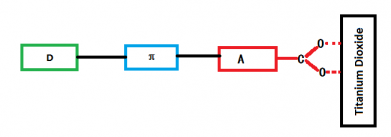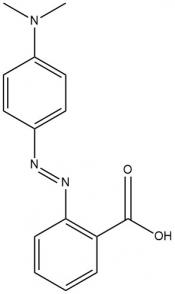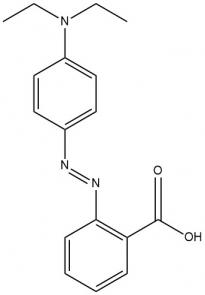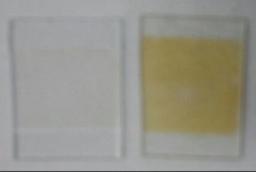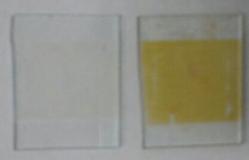论文总字数:27798字
目 录
一 绪论 ………………………………………………………1
1.1 研究背景 ……………………………………………………………………………… 1
1.2 本文内容 ……………………………………………………………………………… 2
二 新型光电系统中的分子/半导体纳米复合体系对材料的要求 …3
2.1 染料分子 ……………………………………………………………………………… 3
2.1.1 染料分子的要求…………………………………………………………………3
2.1.2 染料分子的分类…………………………………………………………………3
2.1.3 偶氮染料…………………………………………………………………………4
2.2 纳米二氧化钛薄膜的要求 …………………………………………………………… 5
三 新型光电系统中的分子/半导体纳米复合体系中的光学特性 … 5
3.1 实验仪器和药品 ……………………………………………………………………… 5
3.2 染料分子溶液的配制和纳米二氧化钛薄膜的制备 ………………………………… 6
3.2.1 染料分子溶液的配制……………………………………………………………6
3.2.2 纳米二氧化钛薄膜的制备………………………………………………………6
3.2.3 纳米二氧化钛薄膜的敏化………………………………………………………7
3.3 染料分子溶液的紫外可见光吸收和荧光性质 ……………………………………… 8
3.3.1 染料分子溶液的紫外可见光吸收性质…………………………………………8
3.3.2 染料分子溶液的荧光性质………………………………………………………9
3.4 纳米二氧化钛薄膜的紫外可见光吸收和荧光性质………………………………… 10
3.4.1 纳米二氧化钛薄膜的紫外可见光吸收性质 …………………………………10
3.4.2 纳米二氧化钛薄膜的荧光性质 ………………………………………………11
3.5 纳米二氧化钛薄膜的敏化…………………………………………………………… 11
3.5.1 纳米二氧化钛薄膜敏化的紫外可见光吸收性质 ……………………………11
3.5.2 纳米二氧化钛薄膜敏化的荧光性质 …………………………………………13
3.6 纳米二氧化钛薄膜敏化后的光致异构现象………………………………………… 14
四 新型光电系统中的分子/半导体纳米复合体系的电学特性…… 16
4.1 实验仪器和药品……………………………………………………………………… 16
4.2 染料分子溶液的配制和纳米二氧化钛薄膜的烧制………………………………… 16
4.2.1 染料分子溶液的配制 …………………………………………………………16
4.2.2 纳米二氧化钛薄膜的制备 ……………………………………………………17
4.3 染料敏化的纳米二氧化钛薄膜的光电流…………………………………………… 17
五 结论…………………………………………………………………26
参考文献 ………………………………………………………………27
致谢 ……………………………………………………………………31
新型光电系统中的分子/半导体纳米复合体系研究
李存钰
, China
Abstract: Dye-sensitized solar cells have the advantages of high photoelectric conversion efficiency, low cost, simple preparation process, and good environmental benignity.This paper studies the preparation of the molecules in the optoelectronic system/semiconductor nanometer composite light anode system, mainly relates to the preparation of nanometer titanium dioxide thin film, azo dyes and 1, 2 - benzenenedithiol and nanometer titanium dioxide thin film sensitized spectroscopic properties and electrical properties of the sensitization of nanometer titanium dioxide thin film and so on. Nanometer titanium dioxide thin films were prepared on the substrate, and the maximum absorption wavelength of the absorption light was 500nm.The anchored group (-COOH) and (-SH) will be adsorbed on the nanometer titanium dioxide film, and the absorption spectra will be expanded.The fluorescence emission intensity of the nanometer titanium dioxide film with 0.5mmol/L was decreased, and the fluorescence emission intensity of the nanometer titanium dioxide film with 0.5mmol/L was enhanced.The photoisomerization of nanometer titanium dioxide films with azo dye sensitization can occur in light, and the absorption of light in the visible region decreases with the increase of light time. Electrochemistry of the nano titanium dioxide thin film have been measured and the photocurrent of the dye-sensitizednanoscale titanium dioxide thin film have been determined. The photocurrent of the nanometer titanium dioxide thin film sensitized by the ethyl and methyl red dye moleculesdecreases (the reverse current increases) when the irradiating light corresponds to the visible region (vice versa). The visible light current produced by the nano-TiO2 film, which is sensitized by the 1, 2- benzenenedithiol dimethyl sulfoxide solution, is unstable at about 0.04μA/cm2.
Key words: Photoanode; Titanium Dioxide; Azo dyes; Dye-sensitized Solar Cell; Photocurrent.
一 绪论
1.1 研究背景
人类活动严重依赖于丰富的自然资源(特别是水、矿物质和能量)。持续的人口增长和对改善生活条件的渴望使人们的能源需求不断增长,这可能远远超出了煤炭、石油和天然气等现有的常规能源供应。据估计,世界能源消耗将在2050年达到27亿瓦时[1,2],这意味着能源消费模式需要以更有效的方式从有限的能源储备转变为可再生资源,这样做可以减少我们对传统化石燃料、矿物和自然资源的依赖。在这方面,利用可再生能源对我们社会的可持续发展和保护我们的星球具有重要意义。
太阳能是可再生能源,太阳能的潜力使地球上任何其他能源资源的潜力相形见绌[1,2]。太阳在1小时内照射地球所产生的太阳能,比地球上人类在一年内消耗的所有能量都要高。因此,太阳能作为地球上最丰富的可再生能源,可以通过热电、光催化、光电(PV)和光电电化学(PEC)技术的实际应用,将其转化为各种形式的能源。其中,光伏技术作为太阳能利用的一种模式,通常被认为在获取太阳能并直接将其转化为电能方面起着至关重要的作用。
在基础研究和工业化方面,光伏技术正在高速发展。从历史上看,太阳能电池的发展,从1954年贝尔实验室设想的第一个晶体硅太阳能电池(SSC)到今天,可以分为三个阶段[3]。第一代太阳能电池被称为硅基太阳能电池(SSCs)。晶体硅电池已证实能量转换效率已经超过了20%,而单晶电池的转化率达到了26.6% [4]。SSCs是一种先进的、经过验证的PV技术,在整个光伏市场中占据绝对主导地位,总市场份额超过了90% [5]。第二代太阳能电池由薄膜太阳能电池所代表,如GaAs和CdTe等等。已确认的记录能量转换效率分别为28.8%、22.1%和22.6%,分别是GaAs、CdTe和CIGS。与硅基和薄膜太阳能电池相比[6],第三代太阳能电池,如染料太阳能电池(DSSCs)和钙钛矿太阳能电池,在新兴的光伏领域有可能降低加工成本。在采用高耐久性效率的加速生命周期测试时[7,8],已经获得了DSSCs的能量转化效率为13%。最新的钙钛矿太阳能电池已经取得的能量转换效率为22.1%,这已经得到了国际权威机构和认证机构的独立认证[6,9]。
与传统的电池相比,染料敏化太阳能电池是一种有效的替代方法,可以从太阳中提供清洁能源[10,11]。它们通过使用一种分子吸收器来模拟自然光合作用,从而将光能转化为电能[3]。将吸附染料分子固定在半导体金属氧化物纳米颗粒表面,作为DSSCs的工作电极,对于通过从染料中注入电子到金属氧化物的传导带而启动电流至关重要。这种固定方式通常是通过添加一个“锚定组”来实现的。一种能够吸附染料分子到金属氧化物表面的化学取代物[12,13]。
剩余内容已隐藏,请支付后下载全文,论文总字数:27798字
相关图片展示:
该课题毕业论文、开题报告、外文翻译、程序设计、图纸设计等资料可联系客服协助查找;

